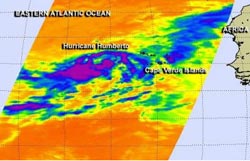2 NASA satellites analyze Hurricane Humberto's clouds and rainfall

NASA's Aqua satellite passed over Hurricane Humberto on Sept. 10 at 11:29 p.m. EDT and revealed cloud cloud-top temperatures in excess of -63F/-52C (purple) in thunderstorms around the hurricane's center of circulation and in bands of thunderstorms west of the center.<br><br>Credit: NASA JPL, Ed Olsen<br>
NASA's Aqua satellite gathered infrared and visible data on Humberto's clouds while NASA's TRMM satellite measured the rainfall rates occurring from those clouds. Humberto is the first hurricane of the Atlantic Ocean hurricane season.
NASA's Tropical Rainfall Measuring Mission satellite called TRMM had an excellent daytime view of strong Humberto on September 10 at 1636 UTC/12:36 p.m. EDT. At NASA's Goddard Space Flight Center in Greenbelt, Md. rainfall derived from TRMM's Microwave Imager (TMI) and Precipitation Radar (PR) data were overlaid on a combination visible/infrared image from TRMM's Visible and InfraRed Scanner (VIRS) to provide a picture of rainfall rates within the storm.
TRMM PR found that the heaviest rainfall associated with Humberto was not near the center of circulation but in convective storms west of the storm. TRMM saw rainfall rates of up to 2 inches/50 mm per hour in the large band of thunderstorms west of Humberto's center. At that time, Humberto was a tropical storm with highest winds near 55 knots (~63 mph).
NASA's Aqua satellite passed over Hurricane Humberto and analyzed the storm in infrared light using the Atmospheric Infrared Sounder known as AIRS and visible light using the MODIS instrument. AIRS gathered data on Sept. 11 at 03:29 UTC/Sept. 10 at 11:29 p.m. EDT and revealed cloud cloud-top temperatures in excess of -63F/-52C in thunderstorms around the hurricane's center of circulation and in bands of thunderstorms west of the center. The MODIS or Moderate Resolution Imaging Spectroradiometer instrument showed a thick band of thunderstorms wrapping into the center from the west.
At 11 a.m. EDT on Sept. 11, Hurricane Humberto made a turn to the north and is expected to continue in that direction for another day or two. It was centered about 340 miles/550 km west of the Cape Verde Islands, near 16.7 north and 29.1 west. Humberto has maximum sustained winds near 80 mph/130 kph and is moving to the north near 9 mph/15 kph.
The National Hurricane Center noted that Humberto could strengthen a little today before weakening on Sept. 12. Humberto is headed for cooler waters and an environment where wind shear is expected to increase which is why it is expected to weaken.
Media Contact
More Information:
http://www.nasa.govAll latest news from the category: Earth Sciences
Earth Sciences (also referred to as Geosciences), which deals with basic issues surrounding our planet, plays a vital role in the area of energy and raw materials supply.
Earth Sciences comprises subjects such as geology, geography, geological informatics, paleontology, mineralogy, petrography, crystallography, geophysics, geodesy, glaciology, cartography, photogrammetry, meteorology and seismology, early-warning systems, earthquake research and polar research.
Newest articles

High-energy-density aqueous battery based on halogen multi-electron transfer
Traditional non-aqueous lithium-ion batteries have a high energy density, but their safety is compromised due to the flammable organic electrolytes they utilize. Aqueous batteries use water as the solvent for…

First-ever combined heart pump and pig kidney transplant
…gives new hope to patient with terminal illness. Surgeons at NYU Langone Health performed the first-ever combined mechanical heart pump and gene-edited pig kidney transplant surgery in a 54-year-old woman…

Biophysics: Testing how well biomarkers work
LMU researchers have developed a method to determine how reliably target proteins can be labeled using super-resolution fluorescence microscopy. Modern microscopy techniques make it possible to examine the inner workings…





















